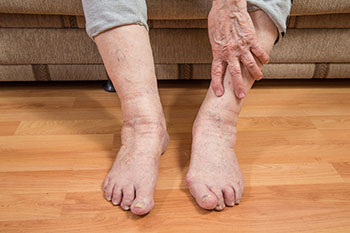
Taking care of ourselves as we age should be a priority. We want to live as long as we can, and have the best quality of life possible. While other aspects of our physical health may take priority, it is equally important to be proactive about our foot and ankle health, as mobility is a key to independent living as we get older.
Foot and ankle conditions among geriatric patients are often due to complications of systemic diseases such as arthritis, diabetes, and circulatory issues. The feet are often the first place where symptoms of these diseases present themselves. So, it is important to be vigilant in detecting early signs of these diseases and seek treatment as soon as possible.
Diabetes and Geriatric Feet
Many older adults have diabetes which can lead to foot problems. Nerve damage associated with diabetes can make it difficult for older adults to detect tiny cuts, abrasions, or hot spots on the feet. Poor circulation also brought on by diabetes can compound this problem by making it difficult for the body to heal even the most minor skin disturbance. That is why it is important for aging adults to inspect their feet and toes every day for any type of cut, bruise, red spot, corn, callus, etc., and see a podiatrist right away if anything unusual is detected. Regular visits to the podiatrist are essential for diabetics to facilitate optimal foot health and early prevention when necessary.
Arthritis and Geriatric Feet
Early detection and treatment can help the elderly patient and their podiatrist manage arthritic symptoms more effectively. It can also help maintain joint functionality and decrease the risk of any potential disability. Any pain, swelling, or stiffness in the feet or ankles should prompt a visit to the podiatrist for diagnosis as soon as possible.
Other Geriatric Foot Conditions
Other common foot and ankle disorders among the elderly include:
- Heel pain
- Ingrown toenails
- Fungal toenails
- Dry skin and cracked heels
- Dorns and calluses
- Bunions
- Hammertoes
- Gait anomalies
Geriatric Foot Care Tips
The following foot care tips can often prevent these issues from developing, and will help older adults maintain optimal foot and ankle health:
- Check feet regularly to monitor foot health and report cuts, sores, or anything unusual to your podiatrist.
- Keep the blood flowing by walking daily, and doing gentle stretching exercises for the feet and toes.
- Try to avoid sitting for long periods of time, and elevate the feet as much as possible.
- Be sure to wear comfortable shoes that fit well and offer ample room in the toe box along with support in the heel and arch.
- Wear moisture-wicking socks that fit comfortably and do not put pressure on any part of the feet or ankles
- Wash and dry feet thoroughly every day to keep infections at bay, and moisturize them to avoid dry or callused skin.
- Never walk barefoot, even around the house
- Keep toenails trimmed straight across but not too short, which may lead to an ingrown toenail. A podiatrist can trim nails for those who cannot do it themselves.
- Do not smoke. Smoking reduces blood supply and may exacerbate swelling and circulatory problems.
- Maintain a healthy body weight by eating a well-balanced diet and staying active.
- Foot pain and decreased mobility is not normal and should not be ignored. Make an appointment with a podiatrist for an examination as soon as possible.
A podiatrist is an essential part of the older adult’s team of healthcare providers. Make an appointment today to learn more about how to keep feet and ankles healthy in order to maintain an active, independent lifestyle.
